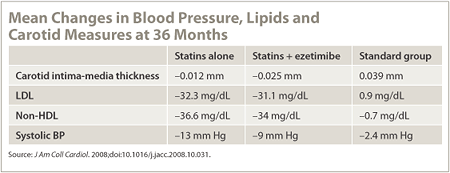SANDS: Nearly identical regression in LDL, carotid IMT with statins alone, statins plus ezetimibe
Patients with type 2 diabetes experienced increases in carotid intima-media thickness with standard treatment.
Aggressive lowering of LDL was accompanied by a similar regression of carotid artery intima-media thickness in patients with type 2 diabetes assigned to statins alone or statins plus ezetimibe during 36 months of follow-up, according to study findings.
Researchers of this secondary analysis of the Stop Atherosclerosis in Native Diabetes Study (SANDS) examined the effect of LDL lowering with statins alone compared with statins plus ezetimibe (Zetia, Merck/Schering-Plough) on common carotid artery intima-media thickness in patients with type 2 diabetes and no history of cardiovascular events. Researchers enrolled 499 American Indian men and women aged 40 years and older with type 2 diabetes (LDL >100 mg/dL; systolic BP >130 mm Hg).
Patients were randomly assigned to an aggressive treatment group (n=252; target LDL <70 mg/dL; non-HDL <100 mg/dL; systolic BP <115 mm Hg) or a standard treatment group (n=247; target LDL <100 mg/dL; non-HDL <130 mg/dL; systolic BP <130 mm Hg). In the aggressive treatment group, patients received statins if lifestyle modification did not lower LDL to the prescribed goals within three months; if the goals were not reached with statins alone, ezetimibe was added.
“For a similar extent of LDL and non-HDL lowering to respective targets of <70 mg/dL and <100 mg/dL, a nearly identical regression in carotid intima-media thickness occurs in patients with type 2 diabetes who achieve similar reductions in these lipid levels from a statin alone vs. statin plus ezetimibe; in contrast, carotid intima-media thickness increased in patients titrated to a conventional LDL target of <100 mg/dL,” the researchers wrote.
At 36 months, LDL was reduced by 32 mg/dL among patients assigned to statins alone and 31 mg/dL among patients assigned to statins plus ezetimibe compared with 1 mg/dL among patients assigned to standard treatment (P<.0001).

A 0.025-mm reduction in carotid intima-media thickness was observed with statins plus ezetimibe compared with a 0.012-mm reduction with statins alone; however, carotid intima-media thickness progressed by 0.039 mm in the standard group (see table).
Multivariate analysis revealed that greater decreases in carotid intima-media thickness correlated with greater reductions in LDL and non-HDL, higher baseline carotid intima-media thickness and younger age. The researchers reported no independent contribution when comparing statins alone with statins plus ezetimibe.
“Thus, comparable LDL and non-HDL lowering accomplished with statins plus ezetimibe vs. statins alone resulted in similar benefit on carotid intima-media thickness,” the researchers wrote.
No serious adverse events were reported with the lipid drugs used in the SANDS trial.

For more information:
- J Am Coll Cardiol. 2008;doi:10.1016/j.jacc.2008.10.031.

![]()
This result is reassuring as it parallels real-life treatment of patients using successive agents to predefined treatment goals. The evidence favors the initial use of statin, titrated as needed to target LDL and non-HDL goals. Most physicians will choose to add a second agent such as ezetimibe if primarily further LDL lowering is needed after statin titration. So while this is not a trial of statin vs. statin plus ezetimibe, it shows us that essentially identical carotid intima-media thickness outcomes can be achieved with the two treatment strategies to achieve a common lipid goal. It is very notable that the standard treatment goals were associated with progression of atherosclerosis at 36 months while the aggressive goals yielded regression, supporting the wider use of the optional Adult Treatment Panel-III intensive goals in patients with diabetes.
– Steven R. Jones, MD
Assistant Professor of Medicine, Johns Hopkins Hospital

![]()
These results are reassuring in the sense that a modest decrease in carotid intima-media thickness was seen in the group that had been treated with ezetimibe plus a statin for approximately three years while no significant change in carotid intima-media thickness was seen in the much larger ENHANCE study over the course of two years. However, this article is a secondary analysis from the larger SANDS trial and it has a number of limitations that the authors addressed. For now, most clinicians will aim to get to lipid targets first with a huge dose of a potent statin. If the LDL and non-HDL targets are not reached using this approach, then the options are to consider niacin, fenofibrate, a resin or ezetimibe. Unfortunately, it will be several more years before we have the results of the randomized, placebo-controlled IMPROVE-IT study that will tell us once and for all whether ezetimibe provides clinical benefit on top of 40 mg simvastatin.
– Roger S. Blumenthal, MD
Director, Johns Hopkins Ciccarone Center for the Prevention of Heart Disease
